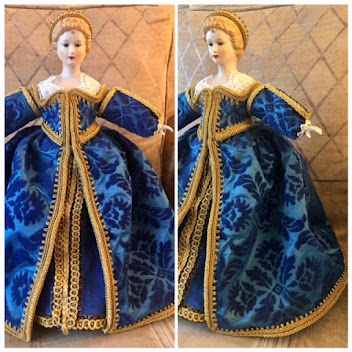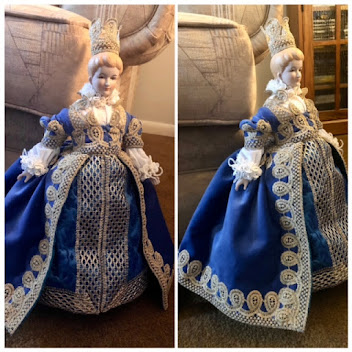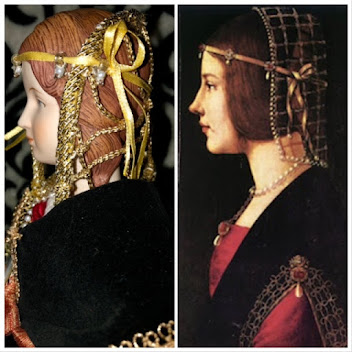While all SCA folks are preparing or arriving for Pennsic, I am on a weed walk local outside of town, living in manicured suburbs has its draw backs. Collected a car trunk load of Teasel to run a small spinning fiber experiment. Since sunflower stalks can be made into spinning fiber, there maybe more semi-woody plants that one can make spinning fibers.
This is true of hessian cloth (burlap) and sack cloth from plant fibers. There are a whole list of cloth fibers from plants most notably linen from flax. Although nettle hemp and jute lost popularity except in certain uses after the production of cotton became popular post period.
Teasel are in the thistle family so they are spiked all over and will need to be scraped of thorns and leaves. My goal to see if it can be retted and made into usable fiber, besides the spikes dried seed pods having use as a natural comb when dry. Which I am saving those to dry and store in a clear latch jar for later use.
Found loads along my local highway but it’s dangerous to harvest along a major freeway. This is just off a public sidewalk. Always ask permission from any property owner before harvesting even unwanted plants.
The Teasel now are green and in full bloom. I am hoping the result would be a grayish brown color of this which is similar to flax, the teasel fiber will be a similar color if all works out. Running this experiment now in a small batch scale-to see if by fall it’s worth obtaining more. The challenge is making sure the waxes and other gum like parts of the plant break down. Seems that a large amount of the plant is needed to harvest a good amount of fibers in most cases. Here is to the Science part of the Sca Arts and Sciences.
It’s science,
THL Marrin O’Cadhla
Sunday, July 28, 2019
Subscribe to:
Post Comments (Atom)
Replica 1560's Venetian Italian Fashion Doll

Replica 1560 French Fashion Doll

Tudor Q and A
What is a Tudorosity?
A mashed combination of the words Tudor and Curiosity to create the word Tudorosity. Tudorosities is the plural form and the deffinition is as follows.
Tudorosity- an desire to learn or know anything about the Tudor dynasty associated with years 1405 through 1603.
Most people ask my why I make the Tudor garb ?
I find the clothing of this era not only beautiful but also challenging to sew. There is much more care and purpose put into making garments and wearing garments in the Tudor Era. I love the look of Tudor so much I wanted to explore the way clothes were made back then and the subtle changes in fashion and styles of time.
How did you get started in this interesting hobby?
I started with art first, I love to draw, paint, and sculpt all the traditional fine arts. So being able to draw helps me visualize the looks I want to create in my garb. History has always been a huge interest of mine and I've had a knack for sewing since I was 7 years old. It all started with doll clothes and I learned cross stitch embroidery from my grandmother when I was little. I am self taught sewer, crochet, knitting, embroidery and tatting. My methods are learned from books mainly and there is still so much more to learn.
What is my favorite outfit and why?
It would be like picking a favorite out of one of my future children, its impossible. I love all my gown creations and really like the distinct differences in all the styles clothing I make for the Tudor Era.
Do you make the whole outfit including hat, shoes, and undergarments?
I do have a goal of making a complete Tudor from the skin out. As of right now I make 90% of my gowns and accessories. The shoes and stockings, are bought online and the petticoats are a close reproduction but not made by me. .
How long does it take to make a gown?
It all depends on the type of gown. The making relies on the time period and class of the design. Generally if I work on it 8 hours a day on a sewing machine it will take 3 days to get the basics and another 5 days to do finish hand-sewing details and beading. So a week to a week and a half if working on it steady for that amount of time. I work a full-time job so it does take longer than a week to complete. I put over 40-100 hours per outfit depending on its complexity, its like its own full time job of sorts.
Do you make renaissance clothing for sale or custom orders?
No, due to new employment and changes in my lifestyle. Unfortunately, I have no time to support sewing for others. Though I recommend sewing lessons for those adventurous few. There are many fine folks who make and sell historical clothing. I suggest guidance with sew from many fine historical enthusiastic costumers out on the internet.
How long have you been making these elaborate costumes?
I have been in the Society of Creative Anachronism coming up on my 18th year. Active since 2004 working at demonstrations and volunteering when I could between working and other life's distractions. I really concentrated on Tudor sewing in 2007 and worked with patterns to learn proper fabrics, techniques, fit, and silhouette. I really enjoy the eras transition from a medieval form fitting layered cotterdie to the boned Tudor kirtle and then to structured Elizabethan clothing.
A mashed combination of the words Tudor and Curiosity to create the word Tudorosity. Tudorosities is the plural form and the deffinition is as follows.
Tudorosity- an desire to learn or know anything about the Tudor dynasty associated with years 1405 through 1603.
Most people ask my why I make the Tudor garb ?
I find the clothing of this era not only beautiful but also challenging to sew. There is much more care and purpose put into making garments and wearing garments in the Tudor Era. I love the look of Tudor so much I wanted to explore the way clothes were made back then and the subtle changes in fashion and styles of time.
How did you get started in this interesting hobby?
I started with art first, I love to draw, paint, and sculpt all the traditional fine arts. So being able to draw helps me visualize the looks I want to create in my garb. History has always been a huge interest of mine and I've had a knack for sewing since I was 7 years old. It all started with doll clothes and I learned cross stitch embroidery from my grandmother when I was little. I am self taught sewer, crochet, knitting, embroidery and tatting. My methods are learned from books mainly and there is still so much more to learn.
What is my favorite outfit and why?
It would be like picking a favorite out of one of my future children, its impossible. I love all my gown creations and really like the distinct differences in all the styles clothing I make for the Tudor Era.
Do you make the whole outfit including hat, shoes, and undergarments?
I do have a goal of making a complete Tudor from the skin out. As of right now I make 90% of my gowns and accessories. The shoes and stockings, are bought online and the petticoats are a close reproduction but not made by me. .
How long does it take to make a gown?
It all depends on the type of gown. The making relies on the time period and class of the design. Generally if I work on it 8 hours a day on a sewing machine it will take 3 days to get the basics and another 5 days to do finish hand-sewing details and beading. So a week to a week and a half if working on it steady for that amount of time. I work a full-time job so it does take longer than a week to complete. I put over 40-100 hours per outfit depending on its complexity, its like its own full time job of sorts.
Do you make renaissance clothing for sale or custom orders?
No, due to new employment and changes in my lifestyle. Unfortunately, I have no time to support sewing for others. Though I recommend sewing lessons for those adventurous few. There are many fine folks who make and sell historical clothing. I suggest guidance with sew from many fine historical enthusiastic costumers out on the internet.
How long have you been making these elaborate costumes?
I have been in the Society of Creative Anachronism coming up on my 18th year. Active since 2004 working at demonstrations and volunteering when I could between working and other life's distractions. I really concentrated on Tudor sewing in 2007 and worked with patterns to learn proper fabrics, techniques, fit, and silhouette. I really enjoy the eras transition from a medieval form fitting layered cotterdie to the boned Tudor kirtle and then to structured Elizabethan clothing.
Replica 1490 Milan Italian Fashion Doll

Based on art by Giovanni Ambrogio
O’Kealy Heraldry



No comments:
Post a Comment